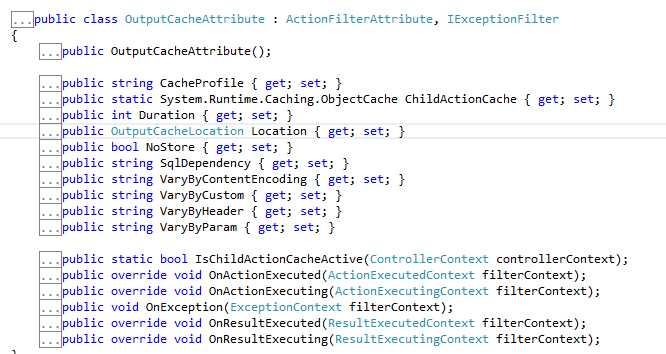标签:
文章来源:http://www.cnblogs.com/JinvidLiang/p/4660200.html(感谢)
ASP.NET MVC 中给我们提供了内置的过滤器,通过过滤器,我们可以在控制器内的方法前后,添加必须的业务逻辑,如权限验证,身份验证,错误处理等。
今天,我们主要介绍3个过滤器:OutputCacheAttribute,AuthorizeAttribute,HandleErrorAttribute。
我们会根据这三个内置过滤器,分别举不同的例子进行解释说明。
1. OutputCacheAttribute
我们先看看源码:

可以看出OutputCacheAttribute继承了ActionFilterAttribute,所以可以重写ActionFilterAttribute的方法OnActionExecuting等,
类中有CacheProfile,Duration,VaryByParam几个属性,下面我们看一下用法。添加如下代码:
[OutputCache(Duration=10)]
public ActionResult OutputCache()
{
ViewData["TimeCache"] = "当前时间是:" + DateTime.Now.ToLongTimeString();
return View();
}
打开浏览器,可以看到,不断刷新,每10秒就会更新一次:

当然,也可以写在页面上,在页面添加代码:
<%@ OutputCache Duration="10" VaryByParam="None" %>
如下面代码:
<%@ Page Language="C#" Inherits="System.Web.Mvc.ViewPage<dynamic>" %>
<%@ OutputCache Duration="10" VaryByParam="None" %>
<!DOCTYPE html>
<html>
<head runat="server">
<meta name="viewport" content="width=device-width" />
<title>OutputCache</title>
</head>
<body>
<div>
<%=ViewData["TimeCache"] %>
</div>
</body>
</html>
或者使用CacheProfile,代码如下:
[OutputCache(CacheProfile = "testProfile")]
public ActionResult OutputCache()
{
ViewData["TimeCache"] = "当前时间是:" + DateTime.Now.ToLongTimeString();
return View();
}
在web.config添加如下配置:
<system.web>
<caching>
<outputCacheSettings>
<outputCacheProfiles>
<add name="testProfile" duration="10" varyByParam="*" />
</outputCacheProfiles>
</outputCacheSettings>
</caching>
</system.web>
2. AuthorizeAttribute
AuthorizeAttribute类的作用,主要是为页面指定操作用户和角色。
我们假设以Session作为页面管理权限,新建一个CustomAuthorize类,添加如下代码:
using System;
using System.Collections.Generic;
using System.Linq;
using System.Web;
using System.Web.Mvc;
namespace MvcMobileDMS.App_Start
{
public class CustomAuthorize : AuthorizeAttribute
{
public override void OnAuthorization(AuthorizationContext filterContext)
{
//假设以Session作为判断页面权限
if (filterContext.HttpContext.Session["temp"] == null)
{
filterContext.HttpContext.Response.Redirect("~/dms/logon");
}
base.OnAuthorization(filterContext);
}
}
}
再在控制器中的方法添加如下代码:
[MvcMobileDMS.App_Start.CustomAuthorize]
public ActionResult Authorize()
{
return View();
}
即可进行权限检查。
3. HandleErrorAttribute
HandleErrorAttribute特性主要用于处理由操作引发的错误。在实际操作中我们可以继承HandleErrorAttribute类,并重写OnException方法来进行错误记录。
首先,我们新建一个错误页:
public ActionResult error()
{
return View();
}
<%@ Page Language="C#" Inherits="System.Web.Mvc.ViewPage<dynamic>" %>
<!DOCTYPE html>
<html>
<head runat="server">
<meta name="viewport" content="width=device-width" />
<title>error</title>
</head>
<body>
<div>
Sorry.an error occoured.
</div>
</body>
</html>
并添加错误处理类ErrorHandle继承自HandleErrorAttribute,代码如下:
using System;
using System.Collections.Generic;
using System.Linq;
using System.Web;
using System.Web.Mvc;
namespace MvcMobileDMS.App_Start
{
public class ErrorHandle : HandleErrorAttribute
{
public override void OnException(ExceptionContext Context)
{
HttpContext.Current.Response.Redirect("~/dms/error");
base.OnException(Context);
}
}
}
在DMS控制器新增一个方法EceptionThrow,并加上过滤器ErrorHandle,代码如下:
[MvcMobileDMS.App_Start.ErrorHandle]
public ActionResult EceptionThrow()
{
throw new ArgumentNullException("filterContext");
}
下面,我们打开浏览器,输入地址:http://localhost:7449/dms/EceptionThrow,显示如下:

当EceptionThrow()方法抛出错误时,ErrorHandle过滤器触发OnException方法,跳转到error页面。
由此可见,我们可以通过HandleErrorAttribute过滤器,处理各种Exception,并使用自定义方法进行处理。
以上,希望能对您有所帮助O(∩_∩)O哈哈~
标签:
原文地址:http://www.cnblogs.com/peiyangjun/p/4665513.html